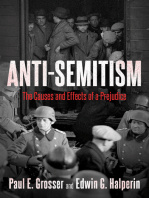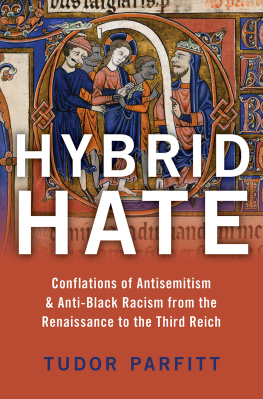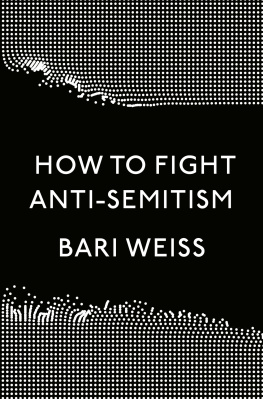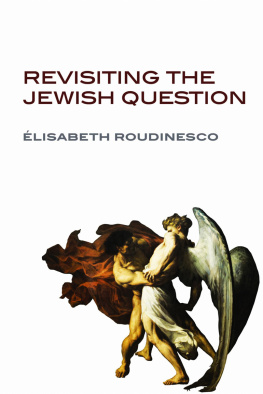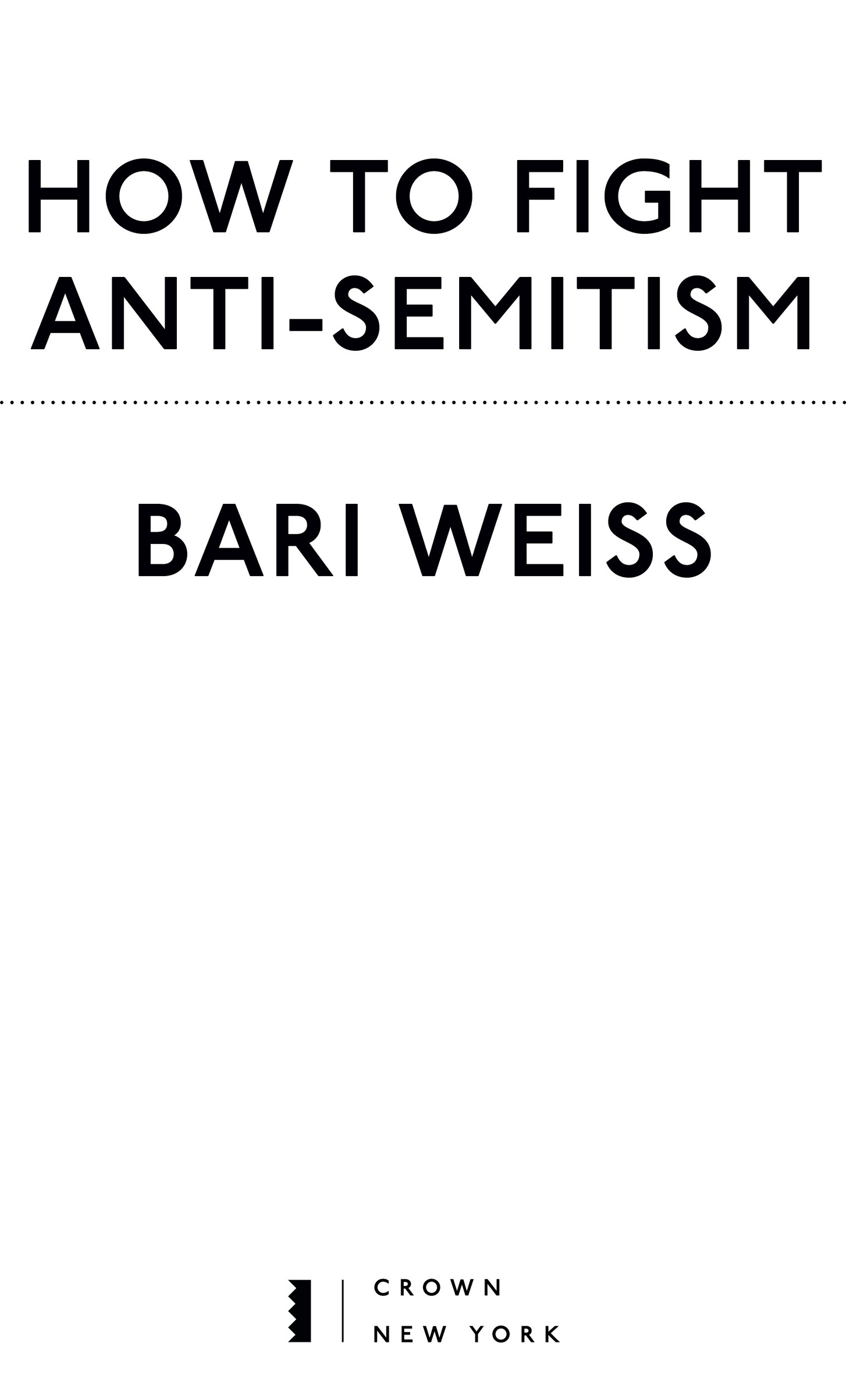All rights reserved.
Published in the United States by Crown, an imprint of Random House, a division of Penguin Random House LLC, New York.
CROWN and the Crown colophon are registered trademarks of Penguin Random House LLC.
Names: Weiss, Bari, author.
Title: How to fight anti-Semitism / Bari Weiss.
Description: New York: Crown, 2019. | Includes bibliographical references.
Identifiers: LCCN 2019026904 (print) | LCCN 2019026905 (ebook) | ISBN 9780593136058 (hardcover) | ISBN 9780593136065 (ebook)
Subjects: LCSH: AntisemitismHistory21st century. | AntisemitismPolitical aspects.
Classification: LCC DS145 .W46 2019 (print) | LCC DS145 (ebook) | DDC 305.892/4dc23
Proclaim Liberty throughout all the land unto all the inhabitants thereof.
LEVITICUS 25:10. AND THE LIBERTY BELL.
CHAPTER 1
WAKING UP
There is a shooter at tree of life.
The first text came through our family chat at 10:22 A.M. It was from my baby sister, Suzy. I typed back immediately: Is dad.
My mouth turned to cotton as I waited for a response to my incomplete question.
My parents live a mile and a half from the Tree of Life synagogue. Three congregations meet in the building for Shabbat morning services; my dad is sometimes at one of them.
Were home, my mom wrote. do t worry.
Casey, my second-youngest sister, had heard more: Magazine high powered ak 47. Doug is on police radio, she said of her husband, a local firefighter.
Someone sent around a link to the Psalmsin you our ancestors trusted; they trusted and you saved themsacred poems Jews have always recited in times of distress. Several texts suggested that there were hostages, early and hopeful speculation. My mom wrote simply: Im sure we will know people there.
Minutes slouched by. I turned on CNN. Nothing yet. I refreshed and refreshed and refreshed Twitter every few seconds. There were posts from some local sources urging people to stay away from the area; warnings that the police had shut down that part of the neighborhood; speculation that the shooter might be on the loose. I thought about the Boston Marathon bombershow one of the Tsarnaev brothers hid in a boat in someones backyardand told my parents not to leave the house.
Soon I started getting WhatsApp messages from close friends in Israel, where Shabbat was endinga strange reversal from the years of the Second Intifada when I would write them: Are you safe?
I checked the news again. Early reports of a shooting in the Squirrel Hill neighborhood of Pittsburgh. No name yet. No victim count. Refresh Twitter.
At some point in those creeping minutes, between Suzys first text and the moment I booked a plane ticket back to my hometown to witness what the killer had done, my third-youngest sister, Molly, told us that she had heard something on the police scanner.
Hes screaming all these Jews need to die.
I didnt yet know that I would come to see that phrase as the one that marked the before and the after. That I would come to see that commandthe one that had been uttered in a different tongue by Amalek, the villain who stalked the weakest of the ancient Israelites in the desert on their way to the Promised Land; the one that had been echoed by Amaleks ilk down through the generations; and the one that was now being shouted in mineas my alarm bell. Those words would wake me up to the fact that I had spent much of my life on a holiday from history. And history, in a hail of bullets, had made its unequivocal return.
But this realization was to come. The morning of October 27, 2018, in a hotel room in Phoenix, I was pouring sweat and drinking lukewarm room-service coffee, replying to my editor at the Times to say yes, I would write a column immediately about what was going on.
This was before I learned that the name of the shooter was Robert Bowers, before I read what he had written on the social media website Gab: There is no #MAGA as long as there is a kike infestation. It was before I knew he believed that the Jewish people were responsible for the sin of bringing Muslims to America: Open you Eyes! Its the filthy EVIL jews Bringing the Filthy EVIL Muslims into the Country!! Bowers hated the Hebrew Immigrant Aid Society, a Jewish organization founded in the late 1800s to resettle Jews fleeing pogroms in Russia and Eastern Europe. Today, it does the righteous work of rescuing Jews and non-Jews facing persecution all over the world. His final post before he entered the building was: HIAS likes to bring invaders in that kill our people. I cant sit by and watch my people get slaughtered. Screw your optics, Im going in. Tree of Life had been one of 270 synagogues around the country that had hosted National Refugee Shabbat the previous Saturday. That morning during services, American rabbis had spoken about the most fundamental and recurrent theme in the Bible: Do not oppress a stranger, because you were strangers in the land of Egypt.
This was before I stood in the sanctuary of the synagogue and watched an FBI agent named Nicholas Boshears break down in tears talking about what hed witnessed in my community. Down the hall, his colleagues, in white coveralls, were cleaning and assessing what had become a crime scene: a chapel with hundreds of shell casings, dried rivers of blood, and tiny pieces of flesh.
It was before I sat with Rabbi Daniel Wasserman in his Squirrel Hill synagogue, Shaare Torah, his eyes wet and wide as he told me about what hed seen. As a member of the communitys chevra kadishaliterally, holy communityhe was tasked with coordinating the cleanup of the bodies in accordance with Jewish law.
Ive seen bodies through taharas, he told me, referring to the ritual purification that takes place before a Jewish burial. But unless someone is a medic in a battle zone or a soldier, I defy anyone to tell me theyve seen that. It was, according to Robert Jones, the FBI special agent in charge of Pittsburgh, the most horrific crime scene hed witnessed in twenty-two years.
Rabbi Wasserman had to shut off his brain so he could do his work. Even so, the images were burned there.
He told me hed seen the dead body of a sweet, intellectually disabled man we both knew splayed at the entrance to the chapel. Cecil Rosenthal always came early to services with his brother, David, proud to serve as an usher and greet everyone who showed up with a prayer book and a wide smile. From the location of his corpse, it seemed that he had welcomed the killer, too.
Wasserman had seen Bernice and Sylvan Simon, who were married in that synagogue, dead in each others arms. He was protecting his wife, the rabbi said of the way their bodies were positioned. He shuddered as he told me about seeing a piece of a persons skull and recognizing immediately whose head it belonged to because he knew exactly how that man kept his hair.
This was before we knew all the names: the Rosenthals and the Simons and Joyce Fienberg and Richard Gottfried and Rose Mallinger and Jerry Rabinowitz and Daniel Stein and Melvin Wax and Irving Younger. It was before we buried them.
I filed the column that afternoon. Early the next morning, I gave the speech that had been my reason for coming to Phoenix. Someone sweet from the audience put a Pirates baseball cap on my head and I wore it as I walked through the airport.



